2006 SUBARU IMPREZA wheel
[x] Cancel search: wheelPage 7 of 365
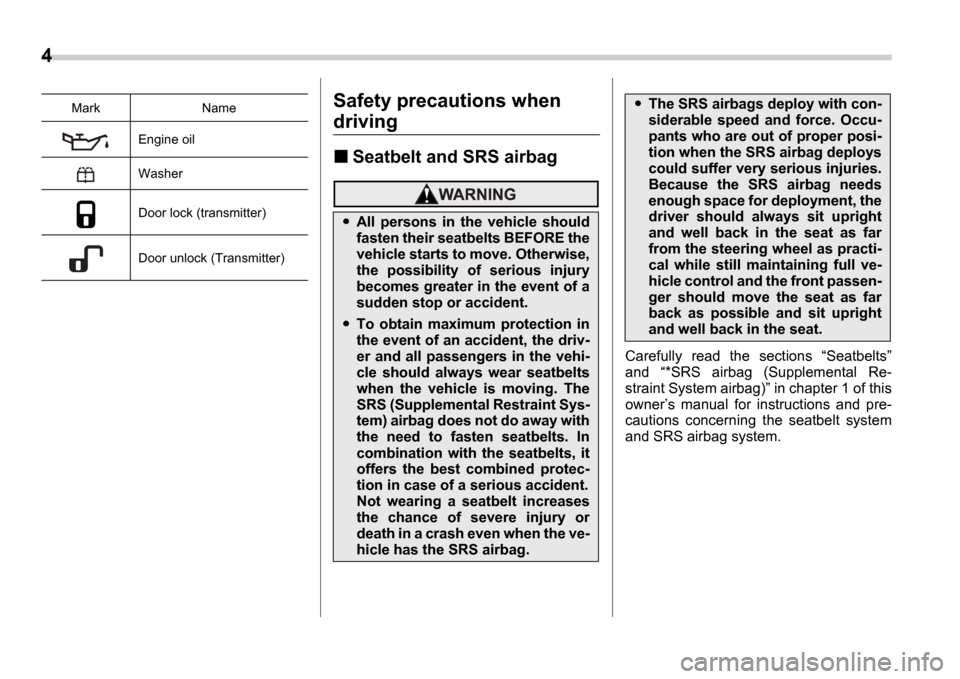
4
Safety precautions when
driving
Seatbelt and SRS airbag
Carefully read the sections Seatbelts
and *SRS airbag (Supplemental Re-
straint System airbag) in chapter 1 of this
owner s manual for instructions and pre-
cautions concerning the seatbelt system
and SRS airbag system.
Engine oil
Washer
Door lock (transmitter)
Door unlock (Transmitter)
Mark Name
All persons in the vehicle should
fasten their seatbelts BEFORE the
vehicle starts to move. Otherwise,
the possibility of serious injury
becomes greater in the event of a
sudden stop or accident.
To obtain maximum protection in
the event of an accident, the driv-
er and all passengers in the vehi-
cle should always wear seatbelts
when the vehicle is moving. The
SRS (Supplemental Restraint Sys-
tem) airbag does not do away with
the need to fasten seatbelts. In
combination with the seatbelts, it
offers the best combined protec-
tion in case of a serious accident.
Not wearing a seatbelt increases
the chance of severe injury or
death in a crash even when the ve-
hicle has the SRS airbag.
The SRS airbags deploy with con-
siderable speed and force. Occu-
pants who are out of proper posi-
tion when the SRS airbag deploys
could suffer very serious injuries.
Because the SRS airbag needs
enough space for deployment, the
driver should always sit upright
and well back in the seat as far
from the steering wheel as practi-
cal while still maintaining full ve-
hicle control and the front passen-
ger should move the seat as far
back as possible and sit upright
and well back in the seat.
Page 9 of 365
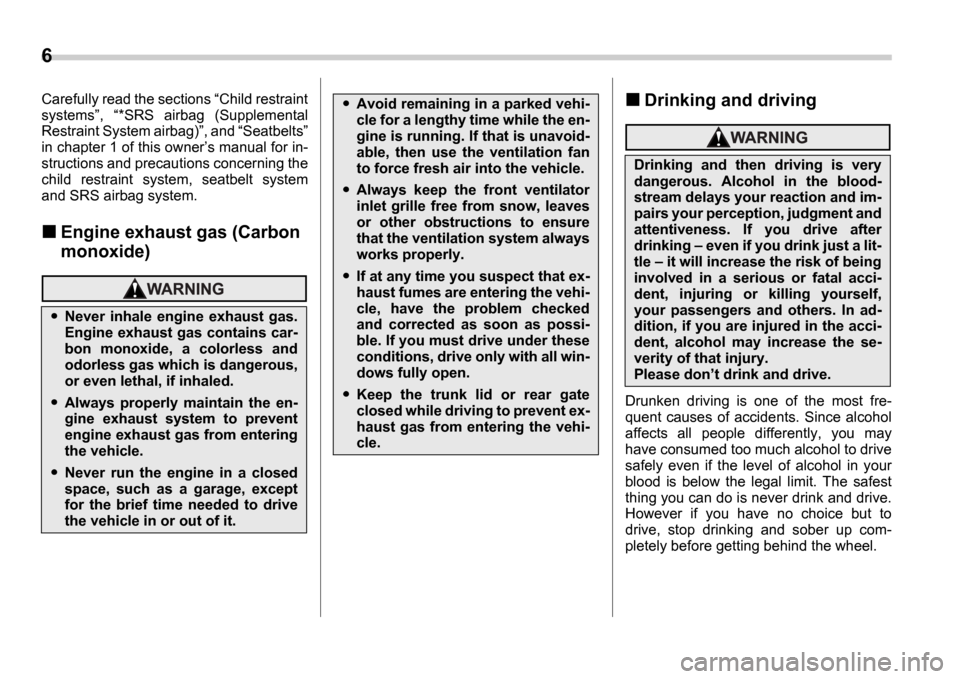
6
Carefully read the sections Child restraint
systems , *SRS airbag (Supplemental
Restraint System airbag) , and Seatbelts
in chapter 1 of this owner s manual for in-
structions and precautions concerning the
child restraint system, seatbelt system
and SRS airbag system.
Engine exhaust gas (Carbon
monoxide)
Drinking and driving
Drunken driving is one of the most fre-
quent causes of accidents. Since alcohol
affects all people differently, you may
have consumed too much alcohol to drive
safely even if the level of alcohol in your
blood is below the legal limit. The safest
thing you can do is never drink and drive.
However if you have no choice but to
drive, stop drinking and sober up com-
pletely before getting behind the wheel.
Never inhale engine exhaust gas.
Engine exhaust gas contains car-
bon monoxide, a colorless and
odorless gas which is dangerous,
or even lethal, if inhaled.
Always properly maintain the en-
gine exhaust system to prevent
engine exhaust gas from entering
the vehicle.
Never run the engine in a closed
space, such as a garage, except
for the brief time needed to drive
the vehicle in or out of it.
Avoid remaining in a parked vehi-
cle for a lengthy time while the en-
gine is running. If that is unavoid-
able, then use the ventilation fan
to force fresh air into the vehicle.
Always keep the front ventilator
inlet grille free from snow, leaves
or other obstructions to ensure
that the ventilation system always
works properly.
If at any time you suspect that ex-
haust fumes are entering the vehi-
cle, have the problem checked
and corrected as soon as possi-
ble. If you must drive under these
conditions, drive only with all win-
dows fully open.
Keep the trunk lid or rear gate
closed while driving to prevent ex-
haust gas from entering the vehi-
cle.
Drinking and then driving is very
dangerous. Alcohol in the blood-
stream delays your reaction and im-
pairs your perception, judgment and
attentiveness. If you drive after
drinking even if you drink just a lit-
tle it will increase the risk of being
involved in a serious or fatal acci-
dent, injuring or killing yourself,
your passengers and others. In ad-
dition, if you are injured in the acci-
dent, alcohol may increase the se-
verity of that injury.
Please don t drink and drive.
Page 11 of 365
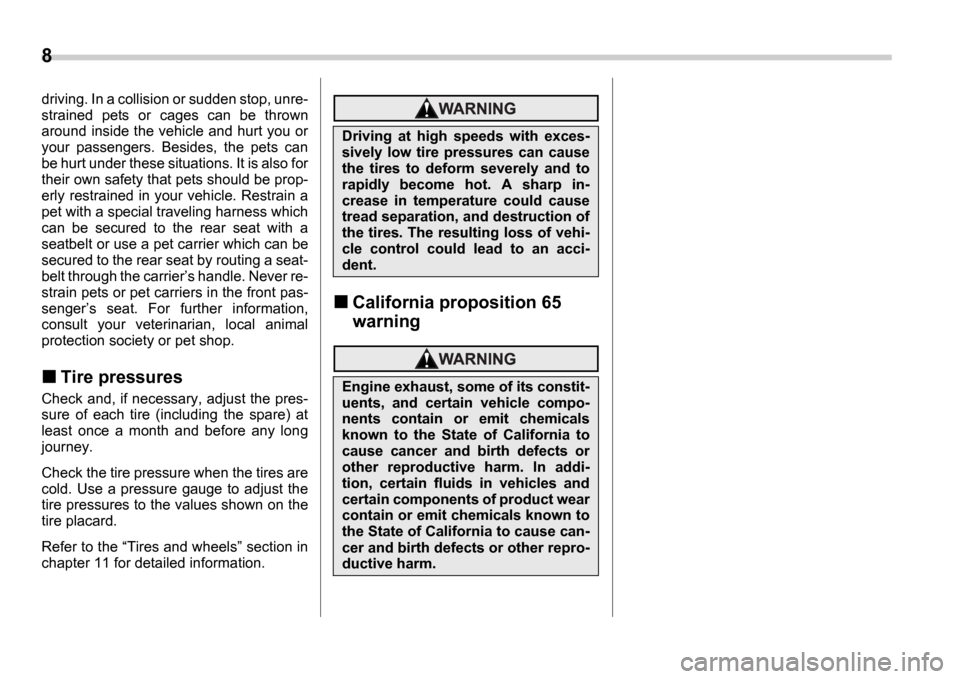
8
driving. In a collision or sudden stop, unre-
strained pets or cages can be thrown
around inside the vehicle and hurt you or
your passengers. Besides, the pets can
be hurt under these situations. It is also for
their own safety that pets should be prop-
erly restrained in your vehicle. Restrain a
pet with a special traveling harness which
can be secured to the rear seat with a
seatbelt or use a pet carrier which can be
secured to the rear seat by routing a seat-
belt through the carriers handle. Never re-
strain pets or pet carriers in the front pas-
senger s seat. For further information,
consult your veterinarian, local animal
protection society or pet shop.
Tire pressures
Check and, if necessary, adjust the pres-
sure of each tire (including the spare) at
least once a month and before any long
journey.
Check the tire pressure when the tires are
cold. Use a pressure gauge to adjust the
tire pressures to the values shown on the
tire placard.
Refer to the Tires and wheels section in
chapter 11 for detailed information.
California proposition 65
warning
Driving at high speeds with exces-
sively low tire pressures can cause
the tires to deform severely and to
rapidly become hot. A sharp in-
crease in temperature could cause
tread separation, and destruction of
the tires. The resulting loss of vehi-
cle control could lead to an acci-
dent.
Engine exhaust, some of its constit-
uents, and certain vehicle compo-
nents contain or emit chemicals
known to the State of California to
cause cancer and birth defects or
other reproductive harm. In addi-
tion, certain fluids in vehicles and
certain components of product wear
contain or emit chemicals known to
the State of California to cause can-
cer and birth defects or other repro-
ductive harm.
Page 25 of 365
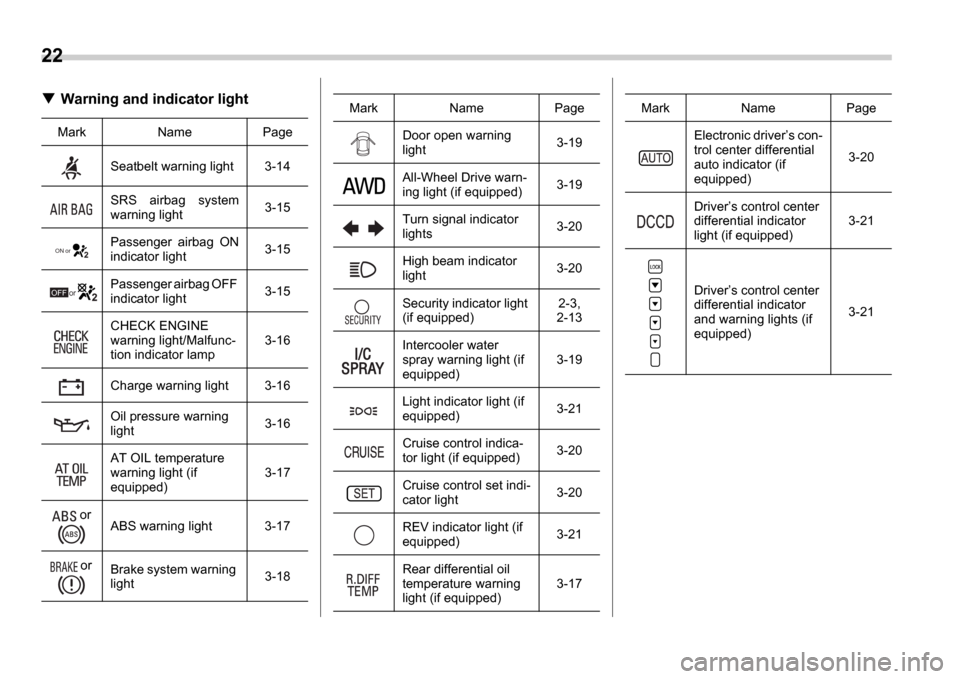
22
Warning and indicator light
Mark Name PageSeatbelt warning light 3-14
SRS airbag system
warning light 3-15
Passenger airbag ON
indicator light 3-15
Passenger airbag OFF
indicator light 3-15
CHECK ENGINE
warning light/Malfunc-
tion indicator lamp 3-16
Charge warning light 3-16
Oil pressure warning
light 3-16
AT OIL temperature
warning light (if
equipped) 3-17
or ABS warning light 3-17
or Brake system warning
light 3-18
ON or
OFF or
Door open warning
light
3-19
All-Wheel Drive warn-
ing light (if equipped) 3-19
Turn signal indicator
lights 3-20
High beam indicator
light 3-20
Security indicator light
(if equipped) 2-3,
2-13
Intercooler water
spray warning light (if
equipped) 3-19
Light indicator light (if
equipped) 3-21
Cruise control indica-
tor light (if equipped) 3-20
Cruise control set indi-
cator light 3-20
REV indicator light (if
equipped) 3-21
Rear differential oil
temperature warning
light (if equipped) 3-17
Mark Name PageElectronic driver
s con-
trol center differential
auto indicator (if
equipped) 3-20
Driver s control center
differential indicator
light (if equipped) 3-21
Driver s control center
differential indicator
and warning lights (if
equipped) 3-21
Mark Name Page
Page 29 of 365

1-2 Seat, seatbelt and SRS airbags
Seat, seatbelt and SRS airbagsFront seats
Never adjust the seat while driv-
ing to avoid the possibility of loss
of vehicle control and of personal
injury.
Before adjusting the seat, make
sure the hands and feet of rear
seat passengers are clear of the
adjusting mechanism.
Seatbelts provide maximum re-
straint when the occupant sits
well back and upright in the seat.
To reduce the risk of sliding under
the seatbelt in a collision, the
front seatbacks should be always
used in the upright position while
the vehicle is running. If the front
seatbacks are not used in the up-
right position in a collision, the
risk of sliding under the lap belt
and of the lap belt sliding up over
the abdomen will increase, and
both can result in serious internal
injury or death.
The SRS airbags deploy with con-
siderable speed and force. Occu-
pants who are out of proper posi-
tion when the SRS airbag deploys
could suffer very serious injuries.
Because the SRS airbag needs
enough space for deployment, the
driver should always sit upright
and well back in the seat as far
from the steering wheel as practi-
cal while still maintaining full ve-
hicle control and the front passen-
ger should move the seat as far
back as possible and sit upright
and well back in the seat.
100082
Put children aged 12 and under in
the rear seat properly restrained at
all times. The SRS airbag deploys
with considerable speed and force
and can injure or even kill children,
especially if they are 12 years of age
and under and are not restrained or
improperly restrained. Because chil-
dren are lighter and weaker than
adults, their risk of being injured
from deployment is greater. Conse-
quently, we strongly recommend
that ALL children (including those in
child seats and those that have out-
grown child restraint devices) sit in
the REAR seat properly restrained
at all times in a child restraint device
or in a seatbelt, whichever is appro-
priate for the child s age, height and
weight. Secure ALL types of child
restraint devices (including forward
facing child seat) in the REAR seats
at all times.
NEVER INSTALL A REARWARD
FACING CHILD SEAT IN THE FRONT
SEAT. DOING SO RISKS SERIOUS
INJURY OR DEATH TO THE CHILD
BY PLACING THE CHILD S HEAD
TOO CLOSE TO THE SRS AIRBAG.
Page 40 of 365
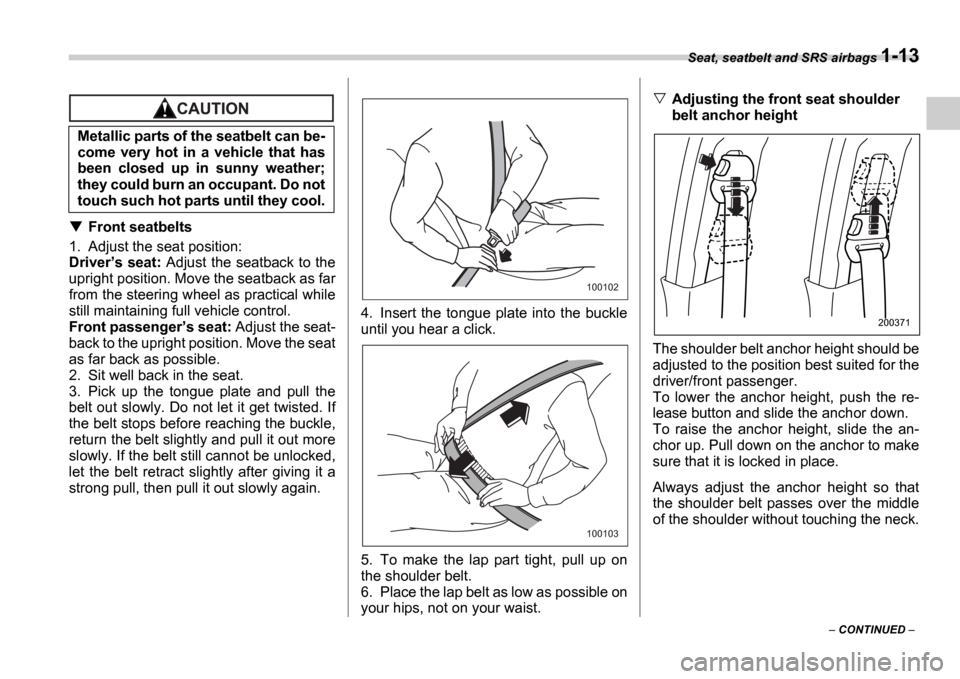
Seat, seatbelt and SRS airbags 1-13
CONTINUED
Front seatbelts
1. Adjust the seat position:
Driver s seat: Adjust the seatback to the
upright position. Move the seatback as far
from the steering wheel as practical while
still maintaining full vehicle control.
Front passenger s seat: Adjust the seat-
back to the upright position. Move the seat
as far back as possible.
2. Sit well back in the seat.
3. Pick up the tongue plate and pull the
belt out slowly. Do not let it get twisted. If
the belt stops before reaching the buckle,
return the belt slightly and pull it out more
slowly. If the belt still cannot be unlocked,
let the belt retract slightly after giving it a
strong pull, then pull it out slowly again. 4. Insert the tongue plate into the buckle
until you hear a click.
5. To make the lap part tight, pull up on
the shoulder belt.
6. Place the lap belt as low as possible on
your hips, not on your waist.
Adjusting the front seat shoulder
belt anchor height
The shoulder belt anchor height should be
adjusted to the position best suited for the
driver/front passenger.
To lower the anchor height, push the re-
lease button and slide the anchor down.
To raise the anchor height, slide the an-
chor up. Pull down on the anchor to make
sure that it is locked in place.
Always adjust the anchor height so that
the shoulder belt passes over the middle
of the shoulder without touching the neck.
Metallic parts of the seatbelt can be-
come very hot in a vehicle that has
been closed up in sunny weather;
they could burn an occupant. Do not
touch such hot parts until they cool.
100102
100103
200371
Page 63 of 365
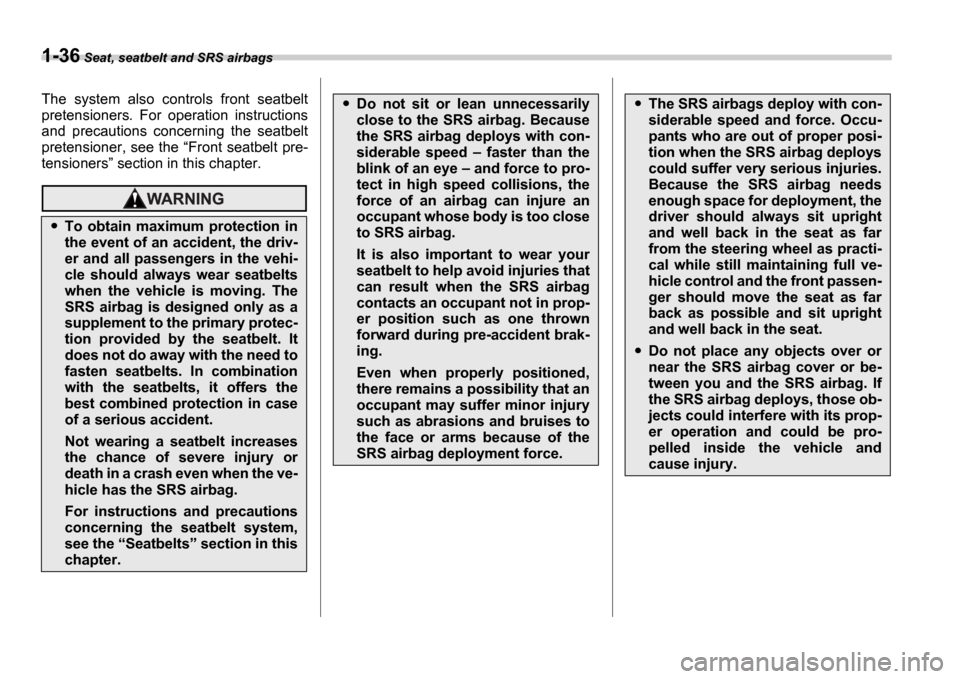
1-36 Seat, seatbelt and SRS airbags
The system also controls front seatbelt
pretensioners. For operation instructions
and precautions concerning the seatbelt
pretensioner, see the Front seatbelt pre-
tensioners section in this chapter.
To obtain maximum protection in
the event of an accident, the driv-
er and all passengers in the vehi-
cle should always wear seatbelts
when the vehicle is moving. The
SRS airbag is designed only as a
supplement to the primary protec-
tion provided by the seatbelt. It
does not do away with the need to
fasten seatbelts. In combination
with the seatbelts, it offers the
best combined protection in case
of a serious accident.
Not wearing a seatbelt increases
the chance of severe injury or
death in a crash even when the ve-
hicle has the SRS airbag.
For instructions and precautions
concerning the seatbelt system,
see the Seatbelts section in this
chapter.
Do not sit or lean unnecessarily
close to the SRS airbag. Because
the SRS airbag deploys with con-
siderable speed faster than the
blink of an eye and force to pro-
tect in high speed collisions, the
force of an airbag can injure an
occupant whose body is too close
to SRS airbag.
It is also important to wear your
seatbelt to help avoid injuries that
can result when the SRS airbag
contacts an occupant not in prop-
er position such as one thrown
forward during pre-accident brak-
ing.
Even when properly positioned,
there remains a possibility that an
occupant may suffer minor injury
such as abrasions and bruises to
the face or arms because of the
SRS airbag deployment force.
The SRS airbags deploy with con-
siderable speed and force. Occu-
pants who are out of proper posi-
tion when the SRS airbag deploys
could suffer very serious injuries.
Because the SRS airbag needs
enough space for deployment, the
driver should always sit upright
and well back in the seat as far
from the steering wheel as practi-
cal while still maintaining full ve-
hicle control and the front passen-
ger should move the seat as far
back as possible and sit upright
and well back in the seat.
Do not place any objects over or
near the SRS airbag cover or be-
tween you and the SRS airbag. If
the SRS airbag deploys, those ob-
jects could interfere with its prop-
er operation and could be pro-
pelled inside the vehicle and
cause injury.
Page 66 of 365
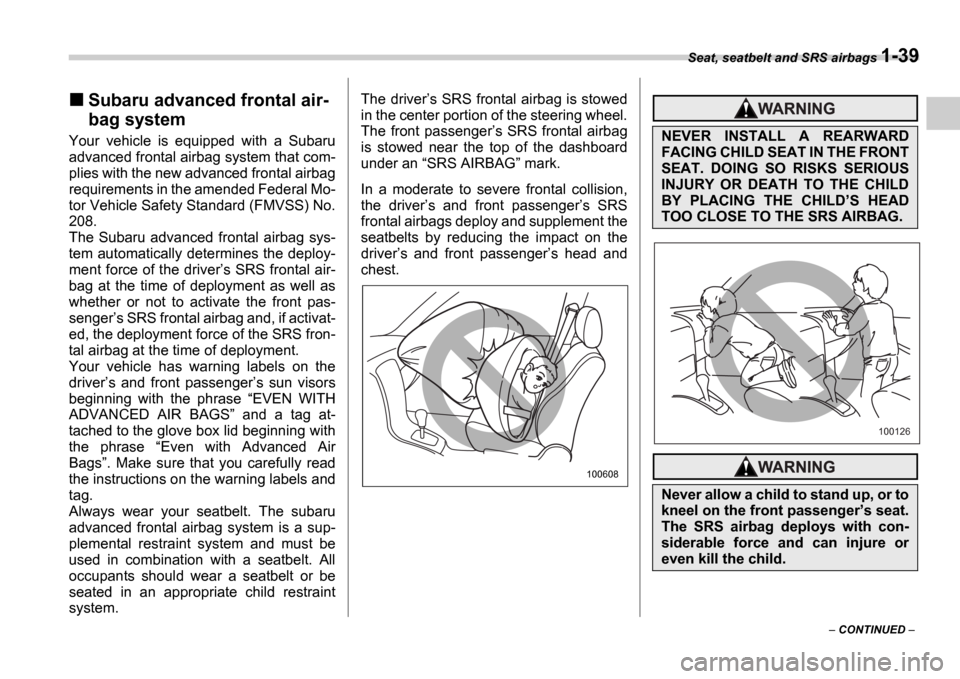
Seat, seatbelt and SRS airbags 1-39
CONTINUED
Subaru advanced frontal air-
bag system
Your vehicle is equipped with a Subaru
advanced frontal airbag system that com-
plies with the new advanced frontal airbag
requirements in the amended Federal Mo-
tor Vehicle Safety Standard (FMVSS) No.
208.
The Subaru advanced frontal airbag sys-
tem automatically determines the deploy-
ment force of the driver s SRS frontal air-
bag at the time of deployment as well as
whether or not to activate the front pas-
senger s SRS frontal airbag and, if activat-
ed, the deployment force of the SRS fron-
tal airbag at the time of deployment.
Your vehicle has warning labels on the
driver s and front passenger s sun visors
beginning with the phrase EVEN WITH
ADVANCED AIR BAGS and a tag at-
tached to the glove box lid beginning with
the phrase Even with Advanced Air
Bags . Make sure that you carefully read
the instructions on the warning labels and
tag.
Always wear your seatbelt. The subaru
advanced frontal airbag system is a sup-
plemental restraint system and must be
used in combination with a seatbelt. All
occupants should wear a seatbelt or be
seated in an appropriate child restraint
system. The driver
s SRS frontal airbag is stowed
in the center portion of the steering wheel.
The front passenger s SRS frontal airbag
is stowed near the top of the dashboard
under an SRS AIRBAG mark.
In a moderate to severe frontal collision,
the driver s and front passenger s SRS
frontal airbags deploy and supplement the
seatbelts by reducing the impact on the
driver s and front passenger s head and
chest.
100608
NEVER INSTALL A REARWARD
FACING CHILD SEAT IN THE FRONT
SEAT. DOING SO RISKS SERIOUS
INJURY OR DEATH TO THE CHILD
BY PLACING THE CHILD S HEAD
TOO CLOSE TO THE SRS AIRBAG.
Never allow a child to stand up, or to
kneel on the front passenger s seat.
The SRS airbag deploys with con-
siderable force and can injure or
even kill the child.
100126